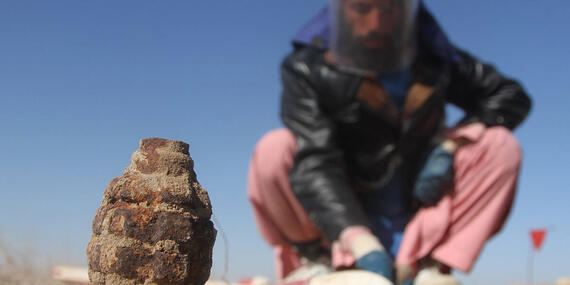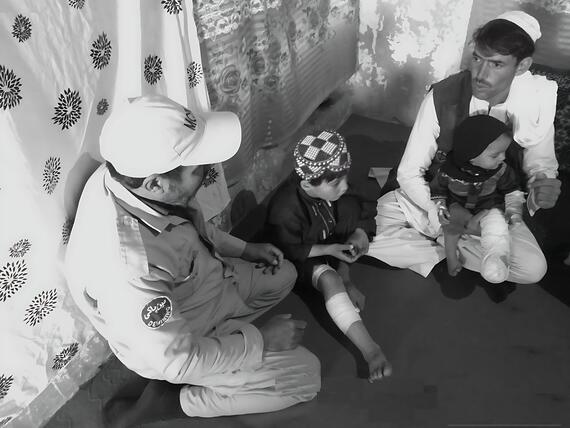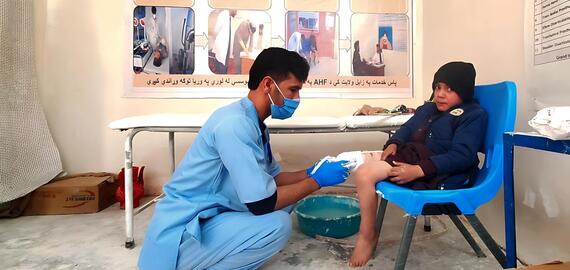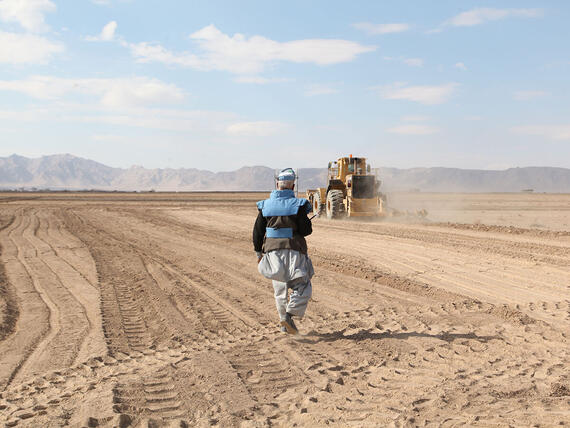Afghanistan: Unearthing hope from a legacy of mines

A dangerous legacy
Afghanistan is among the countries most contaminated with landmines and explosive remnants of war (ERW), which significantly hampers its journey towards recovery and stability. Almost 4 million people are exposed to the constant risk of being harmed, with an estimated 1.2 million m2 of land contaminated by mines, improvised explosive devices and ERW.
Explosive hazards are the second leading cause of civilian casualties in Afghanistan, according to the most recent analysis, which is for between August 2021 and May 2023. There were 1,401 casualties between January 2022 and February 2024, 86 per cent of whom were children.

Afghanistan’s contaminated land includes 262 districts, including areas close to educational institutions and water sources.
Unexploded ordnance threaten people’s physical and mental well-being, curtail land use and impede development. They are a particular threat to people dependent on agriculture-based livelihoods, such as farmers, shepherds and herders, and to refugees, vulnerable migrants and returnee populations.
People who survive encounters with explosives often face various life-changing challenges, such as loss of limbs, hearing impairments, shrapnel wounds, post-traumatic stress disorder, anxiety and depression. They require long-term medical care and rehabilitation, potentially leading to financial strain and reduced quality of life. All of this affects their well-being and ability to reintegrate into society. The ripple effects extend to families and communities.
A significant contributor to these incidents is the collection of scrap metal—a perilous yet common practice among Afghan families seeking an income. In the last two years, ERW accounted for 88 per cent of incidents. Families gather and sell metal from unexploded ordnance, but distinguishing between harmless scrap and live munitions can be dangerous, difficult and often fatal.

Educating for safety and potential recovery
To address this issue, mine action partners have undertaken extensive efforts to educate communities, especially children, about the risks of explosive ordnance. In regions littered with landmines and unexploded ordnance, knowledge of these dangers and how to avoid them can prevent fatalities and serious injuries. This empowers people to make informed decisions when navigating their surroundings, minimizing the risk of accidents. It also facilitates community engagement in mine action efforts, encouraging local participation in identifying and reporting hazardous areas.

Transforming lives and landscapes
Clearing explosive hazards transforms communities. Access to education, health care and natural resources is restored, and communities regain a sense of normalcy. It also opens the door to development opportunities. Infrastructure projects, such as roads, bridges and irrigation systems, previously hindered by explosive contamination, become feasible, significantly contributing to local and national development.
In a recent study by the United Nations Mine Action Service, interviewees shared the significant transformation their communities experienced following the removal of explosive devices from their villages and neighbouring areas.
One of the most immediate and powerful changes is the restoration of safe access to education. Once confined by the fear of landmines, children can now attend school, pursue their dreams and contribute to their country’s future.
Clearance operations save lives directly but also indirectly by improving people’s access to essential health-care services. Isolated communities witnessed a significant shift, as transporting sick people to health centres is no longer a gamble with life.
Removing mines and ERW also rejuvenates communities' social and economic structure. Simple yet fundamental aspects of daily life once fraught with danger, such as visiting relatives, or attending weddings and funerals, are now embraced with joy and relief. Community bonds once strained by the constant threat of explosives begin to return, strengthening social cohesion.
The economic benefits are equally transformative. Access to clean water is a significant milestone for communities. Clean pathways to streams, springs and other natural resources facilitate water access and support agricultural activities. Irrigation becomes feasible, and people can plant crops and raise livestock without the looming threat of the remnants of war. Revitalising agriculture is essential for sustainability and food security, directly affecting the livelihoods of countless Afghan families.
Facing a funding crisis
The journey from a land scarred by hazards to one brimming with potential illustrates the profound impact of mine action. However, Afghanistan’s mine action sector is crippled by a severe funding shortfall.
Of the 4.4 million people who need mine action services in 2023, only 14 per cent received assistance.
The initiatives most affected are for mine clearance, risk education and survivors' assistance. Some projects have stopped, whereas others have secured funding only until August 2024.
This trend continues into 2024, with a mere 13 per cent of the required funding pledged.
The stories of life after clearance in Afghanistan are powerful reminders of the difference that concerted, compassionate action can make. The international community must strengthen its support for one of the country's most significant issues.
